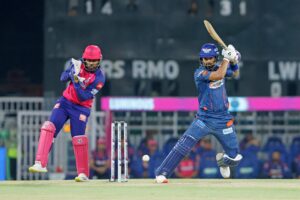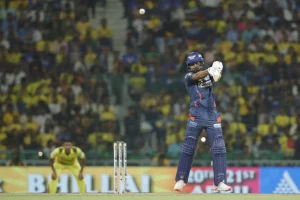
Slowly but surely, KL Rahul is finding his rhythm again. He appears more confident and decisive in his approach, demonstrating a clearer vision of how he intends to navigate this format. Just a year ago, Rahul faced criticism for his sluggish strike rate, batting at a mere 113 in the IPL. It was hard to believe that this was the same player who previously boasted a strike rate of 158.41 in 2018.
However, in IPL 2024, there is a noticeable transformation in Rahul’s gameplan. The batting numbers are evident. Accumulating a total of 378 runs at an impressive average of 42 and a strike rate of 144.27, Rahul has shown significant improvement over the previous year.
With the ICC T20 World Cup around the corner and Rahul being among the top contenders, it was imperative for him to address a key aspect of his game emphasised by Team India skipper Rohit Sharma and the selectors: Strike rate. This adjustment was initiated by the player himself, a remarkable change from his previous stance on the matter, where he once controversially stated that strike rate doesn’t matter in T20s.
Despite being recognised as one of the most prolific run-scorers in the IPL for a considerable period, Rahul, as an opener with the advantage of the powerplay overs, has often started his innings at a painstakingly slow pace. However, recent improvement suggests a promising shift in approach, auguring well for both his individual performance and the success of his team.
For the Latest Sports News: Click Here

Between 2019 and 2023 in the IPL, Rahul accumulated a total of 2,779 runs at an average of 52.43. However, during this period, his strike rate in the powerplay was just 116.8.
To provide context, among the 13 other openers who played over 40 innings in this timeframe, none had a powerplay strike rate lower than 120. Only four other batters had a powerplay strike rate below 130.
Despite his ability to score runs, Rahul’s lack of intent during the powerplay became increasingly problematic. His disappointing performance in the ICC T20 World Cup, where he managed a strike rate of 89.47 in the powerplay and failed to deliver when it counted, raised significant concerns. Consequently, he has not represented India in T20 cricket since November 2022.
During this time, Rahul adhered to the belief that ‘strike rate doesn’t matter in T20s. However, this season, he has adopted a different approach.
“I have realised that T20 cricket has changed in the last couple of years. 170-180 does not always cut it. You have to go harder in the powerplay. The Impact player gives you depth and that gives you more freedom. I have not played T20 cricket in a long time,” Rahul told broadcasters.

Rahul’s performance against Rajasthan Royals harked back to his formidable displays in 2018. The LSG opener smashed an impressive 76 runs off just 48 deliveries, reaffirming his ability to dominate while playing fearless cricket.
This year, Rahul’s approach has undergone a noticeable transformation. Perhaps he now acknowledges the significance of a well-regarded ‘strike rate’. The 32-year-old is now more concerned about the rate at which he is scoring runs than the amount of runs he is scoring. It’s noteworthy that while a higher strike rate can yield quick runs, it is also risky.
In the fast-paced world of T20 cricket, strike rate is often considered the ultimate metric of a batter’s effectiveness. While it is undeniably crucial, it’s imperative to recognise that not all innings are the same. Rahul’s approach, characterised by meticulous accumulation rather than explosive hitting, serves a distinct purpose within the team’s strategy.
Moreover, scrutinising Rahul’s strike rate in isolation overlooks the dynamic nature of T20 cricket. Situational awareness, match conditions, and team requirements often dictate the tempo of an innings. Rahul’s adaptability in adjusting his game according to the needs of the team is a testament to his cricketing acumen.
As far as making a comeback in the T20I side for the T20 World Cup is concerned, Rahul is still very much in contention, if not as a wicketkeeper-batter, then perhaps as a backup opener.
Also Read: R Ashwin, Sunny Gavaskar and not losing hope